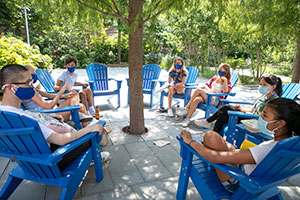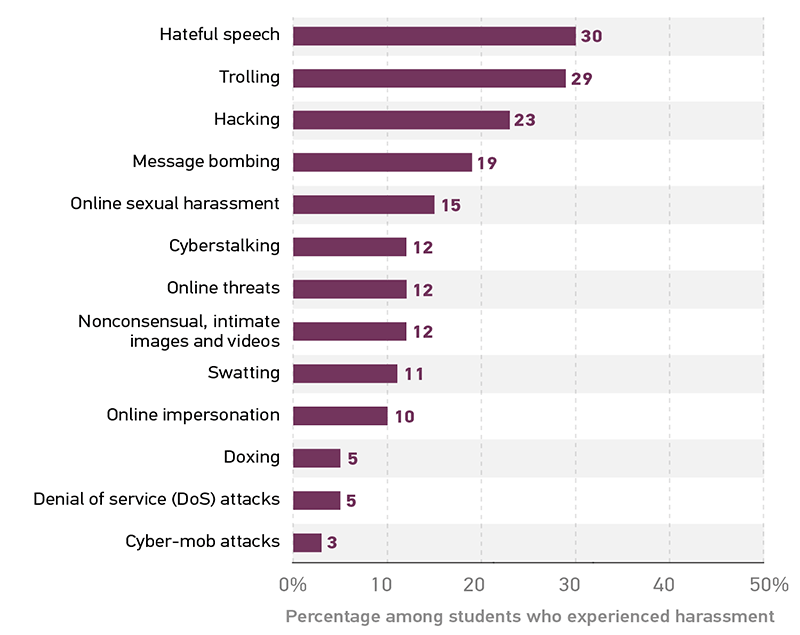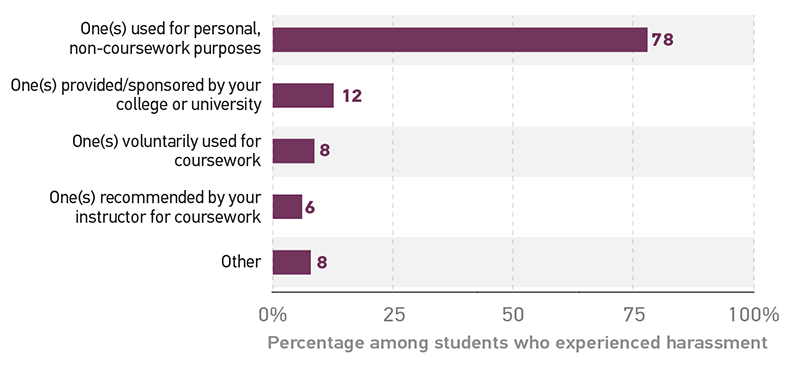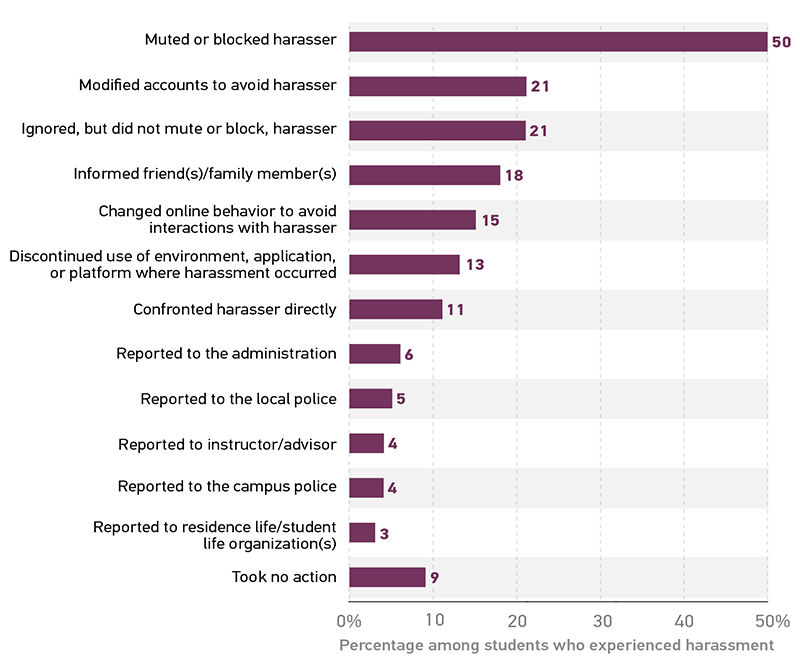Online Harassment
Key Findings
- Although the majority of students have not experienced online harassment, ethnic minority and female students more often experience the more harmful forms of online harassment than do their peers.
- Students from underrepresented racial/ethnic groups are more likely to be harassed on school platforms than their peers.
- Students are more likely to take action themselves to address online harassment than to report it to their institution, friends/family, or law enforcement.
- More students are either dissatisfied or neutral than satisfied with the outcome of the actions they took to address online harassment.
Actions You Can Take
- Strengthen student codes of conduct and policies for responding to online harassment based on the different kinds and severity of harassment individuals experience. Define what constitutes harassment in online environments, even if harassment takes place in nonacademic settings or via the use of personal devices. PEN America's Online Harassment Field Manual provides a useful Glossary of Terms for defining types of online harassment, as well as best practices for protecting users and responding to attacks.
- Foster an anti-harassment culture by training students, faculty and staff about online harassment. Incorporate "bystander intervention" education to help the campus community recognize different types of harassment, and encourage the reporting of attacks that threaten student safety and wellbeing, and/or interfere with academic participation. The Cyberbullying Research Center and the Tyler Clementi Foundation both offer resources that can be useful in the development of programs and workshops.
- Develop a centralized system for reporting and tracking instances of online harassment, and the actions taken to investigate and address cases. While taking personal action is immediate and crucial, strong and accessible reporting mechanisms are needed to help constrain online harassment and foster safe and inclusive environments for students. In their 2019 report "Changing the Culture: Tackling online harassment and promoting online welfare," Universities UK suggests expanding online reporting systems and shares case study examples of impact for consideration.
Peers You Can Connect With

Responsible Use of Online Classroom Content
Richland Community College
In the spring of 2020, Leadership at Richland Community College was made aware that students were posting other students' identifiable classroom work (assignments, discussion board posts) to social media, in some instances creating a threat to those students' safety. In response to these reports, the institution drafted a new campus-wide Responsible Use of Online Classroom Content policy, codifying the institution's standards of behavior in this area and formalizing the institution's response to reported instances of policy violations.

Stalkerware and Digital Harassment: A Security Toolkit for First-Year Students
Duke University
Identifying a growing need for awareness and resources on issues such as cyberstalking, stalkerware, and gender violence, the Duke Cyber Policy and Gender Violence Initiative organization collaborated with the IT Security Office to create a cyberstalking and stalkerware training module for all incoming first-year students. This module was designed to help students recognize the patterns typically found in cyberstalking and stalkerware cases and to equip them with the information and resources they would need to effectively address those issues.
Of Haters, Trolls, and Hackers

Although the majority of students (84%) reported that they have not experienced online harassment, ethnic minority and female students more often reported experiencing the more harmful forms of online harassment than do their peers.1 Students who identified their race/ethnicity as multiple or "other" were more likely to report experiencing hate speech, trolling, online sexual harassment,2 and online threats than students in other racial/ethnic groups.3 And female students were more likely than male students to report experiencing online sexual harassment and the nonconsensual sharing (or the threat of sharing) of intimate images and videos.
No Safe Spaces Online

Students from underrepresented racial/ethnic groups are more likely to be harassed on school platforms than their peers. Although most of the online harassment that all respondents told us they experienced occurs in environments used for personal, non-coursework purposes, more Black/African American (17%), Hispanic/Latinx (17%), and Asian/Pacific Islander (13%) students said they are harassed in environments or apps their institution provides or sponsors than white students (11%). Black students are also more likely than individuals of other races/ethnicities to encounter harassment on platforms that are recommended by their instructors. Though our data don't reveal the actual content of the harassment encountered by the Black students in our sample, other studies have shown that race-based attacks can significantly impact students' feelings of safety, security, and belonging at their institutions.4
Mute, Block, Ignore, Move On

Students are more likely to take action themselves to address online harassment than to report it to their institution, friends/family, or law enforcement. Half of respondents reported blocking or muting their harasser, which was the most common action taken, followed by modifying one's account to avoid a harasser and ignoring (but not muting or blocking) the harasser. More women than men said they mute or block their harasser and/or inform friends or family members. Many students wrote in their open-ended responses that blocking/muting or just ignoring their harasser is effective (e.g., "Most online harassment can be ignored"). Others seemed resigned to the idea that some level of harassment is inevitable when using many tech apps and platforms. These attitudes may be indicative of the "wide spectrum of harm"5 that many women experience online and that some behaviors are considered a nuisance, while others may be more severe and threatening.
You Get Used to It

More students were either dissatisfied (15%) or neutral (41%) than satisfied (45%) with the outcome of the actions they took to address online harassment. Reasons cited for lack of satisfaction reflect a combination of indifference and resignation. For example, one student said, "I'm more or less used to it and apathetic to it at this point." Other comments suggest that some students have experienced more harmful attacks and feel that reporting it would do no good or could make the situation even worse. These findings indicate that many students may be accustomed to or tolerant of certain kinds of online harassment. Women reported lower rates of overall satisfaction (43%) than men (51%) with the outcomes of actions to address harassment. As noted earlier, these attitudes may be indicative of the varying types and degrees of harm that many women experience online and that some behaviors are considered a mere nuisance. This disparity could also relate to differences in how seriously men versus women view online harassment,6 the different kinds of online attacks experienced by men and women, and/or the broader cultural attitudes that downplay the types of harassment women encounter.
Notes
-
The online harassment typology choices included in the survey were developed using PEN America's Online Harassment Field Manual as a guide.
↩︎ -
Although we did not define this term in the survey, PEN America's Online Harassment Field Manual includes "unwelcome sexual requests, comments, and content" in their definition of "online sexual harassment."
↩︎ -
Choices for the ethnic background question included American Indian/Native American/Alaskan native, Asian/Pacific Islander, Black/African American, Hispanic/Latino, White, Other, and prefer not to answer. Respondents could select all that applied.
↩︎ -
Sara Weissman, "Campus Climate Issues Don't Disappear When Campuses Close, Scholars Say," Diverse Issues in Higher Education, April 21, 2020; Keilah Davis, Alicia Thomas, Rachael Davis, and Boz Kaloyanov, "Slurs in Group Message Stoke Racial Tensions," Technician, January 24, 2019; and Jake New, "Can You Hear Us Now?" Inside Higher Education, September 24, 2014.
↩︎ -
Jaigris Hodson, Chandell Gosse, George Veletsianos, and Shandell Houlden, "I Get By with a Little Help from My Friends: The Ecological Model and Support for Women Scholars Experiencing Online Harassment," First Monday 23 no. 8 (August 6, 2018).
↩︎ -
A 2017 Pew Research study found that dramatically more young women than young men saw online harassment as a major problem. "Young men or women" were defined as those between the ages of 18 and 29. Eighty-three percent of young women consider online harassment a major problem compared to only 55% of young men. See Maeve Duggan, "Online Harassment 2017," Pew Research Center, July 2017.
↩︎